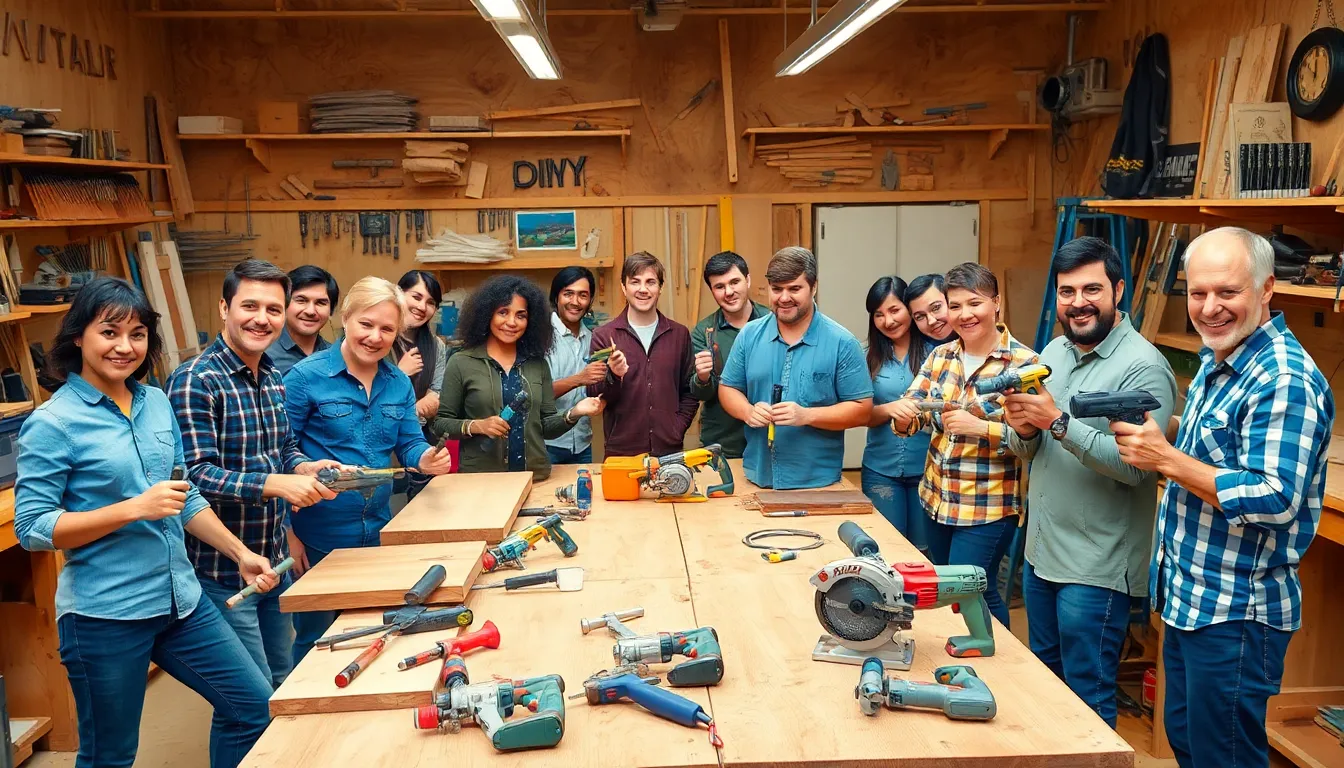Every DIY enthusiast knows that a well-equipped workshop is the secret sauce to turning dreams into reality. Whether it’s building a birdhouse or crafting a custom coffee table, the right tools can make all the difference. Imagine trying to assemble a masterpiece with nothing but a rusty hammer and a prayer—talk about a recipe for disaster!
Table of Contents
ToggleTypes of Workshop Tools and Equipment
A well-rounded workshop includes various tools and equipment tailored to specific tasks. Understanding these types enhances the overall efficiency and effectiveness of any DIY project.
Hand Tools
Hand tools provide essential functionality for numerous tasks. Popular examples include hammers, wrenches, and screwdrivers. Each type serves its purpose, offering precision and control in varied applications. Beyond basic repairs, users rely on pliers and utility knives for intricate work. Maintenance remains easy, as hand tools typically require minimal upkeep.
Power Tools
Power tools significantly enhance productivity in workshop settings. Electric drills, circular saws, and sanders fall within this category, enabling users to complete tasks quickly and accurately. These tools save time during complex projects, offering superior performance compared to hand tools. Battery-operated options provide convenience in mobility, while corded tools offer consistent power. Users should observe safety protocols to prevent accidents while operating these tools.
Measuring Tools
Measuring tools ensure accuracy and precision in any workshop. Common examples include tape measures, squares, and levels. Proper measurements prevent costly mistakes, contributing to a successful project outcome. Digital calipers and laser distance meters offer advanced options for precise calculations. Each measuring tool plays a crucial role in validating dimensions, keeping everything on track throughout the project.
Essential Tools for Every Workshop

A well-equipped workshop requires essential tools for effective project execution. The right tools enhance both precision and productivity in DIY tasks.
Basic Hand Tools
Hand tools are fundamental in any workshop. Hammers provide the necessary force for driving nails and assembling components. Screwdrivers allow for easy fastening and unfastening of screws, ensuring secure connections. Pliers enable users to grip, twist, and cut materials with precision. Wrenches are indispensable for securing nuts and bolts, making adjustments simple. Utility knives offer versatility for cutting various materials, from wood to packaging. Each of these tools contributes to greater control and accuracy in projects.
Recommended Power Tools
Power tools significantly increase productivity in the workshop. Electric drills facilitate rapid drilling and driving of screws, making assembly faster and easier. Circular saws provide clean cuts in wood and sheet materials, reducing manual effort. Sander tools help achieve smooth surfaces, enhancing the finish of projects. Table saws are essential for precise cuts in larger pieces of wood, enabling complex constructions. Additionally, jigsaws allow for intricate cuts, perfect for creative designs. These power tools streamline tasks and improve overall project efficiency.
Safety Equipment for Workshop Use
Safety equipment plays a crucial role in ensuring protection during workshop activities. Proper gear minimizes the risk of injury and promotes a secure working environment.
Personal Protective Equipment (PPE)
Personal Protective Equipment includes essential items like safety glasses, gloves, helmets, and hearing protection. Safety glasses shield eyes from flying debris during cutting or drilling. Durable gloves protect hands while handling tools or materials. Helmets guard against potential head injuries in areas with overhead hazards. Hearing protection limits exposure to loud machinery, preventing long-term hearing loss. Using PPE consistently ensures that individuals remain safe while tackling various projects.
Safety Procedures
Following established safety procedures reduces risks associated with workshop tasks. Adhering to guidelines like keeping the workspace organized prevents accidents related to tripping or slipping. Regularly inspecting tools for defects enables early detection of wear or damage. Using equipment as intended, according to manufacturer instructions, minimizes the chance of mishaps. Additionally, maintaining clear communication among workers enhances safety awareness. Implementing these practices cultivates a culture of safety in the workshop.
Maintenance of Workshop Tools and Equipment
Maintaining workshop tools and equipment ensures longevity and optimal performance. Proper care can prevent malfunctions and reduce replacement costs.
Cleaning and Lubrication
Cleaning tools regularly removes debris and prevents rust. Use a dry cloth for hand tools and a soft brush for more intricate parts. Lubrication reduces friction and wear, allowing machinery to operate smoothly. Apply oil to moving parts of power tools to enhance their efficiency. Schedule cleanings after each use or more frequently for high-usage items. Implementing a routine cleaning and lubrication schedule promotes longevity and reliability.
Storage Solutions
Effective storage solutions protect tools from damage and create an organized workspace. Wall-mounted racks for hand tools maximize space. Use drawer organizers to categorize small items for easy access. Storing power tools in their cases prevents dust accumulation and damage. Consider temperature-controlled environments to avoid issues caused by humidity. Implementing structured storage practices enables seamless workflow and tool preservation.
Choosing the Right Tools for Your Needs
Selecting appropriate tools enhances efficiency and ensures project success. Understanding personal project requirements is essential for an effective workshop setup.
Assessing Your Projects
Identifying the types of tasks determines the tools necessary for success. For example, intricate projects require precise hand tools like screwdrivers and pliers. Larger, more ambitious undertakings benefit from power tools such as drills or saws. Evaluating project complexity helps define specifications, ensuring optimal tool selection. Knowledge of intended materials also plays a critical role; wood projects often require different tools compared to metalworking. Skimming through project requirements and potential challenges guides the tool selection process.
Budget Considerations
Establishing a budget is essential when choosing tools. Considering the current market, many high-quality tools range from budget-friendly options to premium brands. Identifying a price range can help narrow down choices without sacrificing quality. Investing in well-constructed tools often pays off, as they perform better and last longer. Prioritizing necessary tools over less critical equipment maximizes resources. Shopping during sales or exploring second-hand options enables individuals to find decent tools within a constrained budget. Regardless of the financial limits, pacing purchases ensures every project can be tackled efficiently.
A well-equipped workshop is vital for anyone looking to tackle DIY projects effectively. The right tools not only enhance productivity but also ensure safety and precision. By investing in quality hand tools, power tools, and measuring instruments, individuals can significantly improve their project outcomes.
Moreover, prioritizing safety through proper equipment and procedures creates a secure working environment. Regular maintenance and organized storage further extend the life of tools and enhance workflow. Understanding project requirements and budget constraints helps in making informed choices when selecting tools.
With the right setup and a commitment to safety and maintenance, anyone can turn their workshop into a hub of creativity and efficiency.


